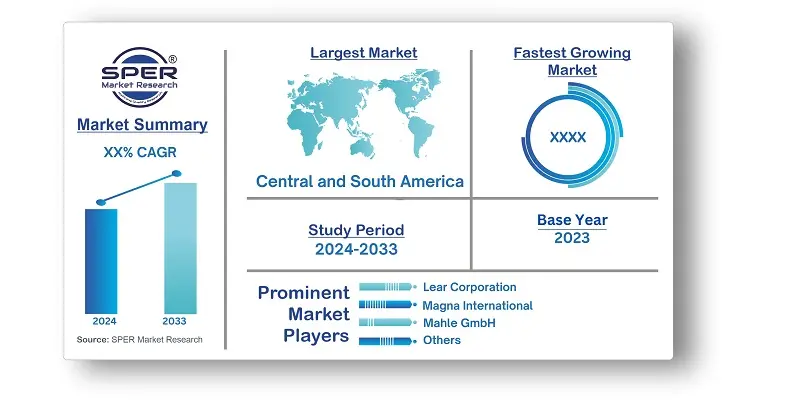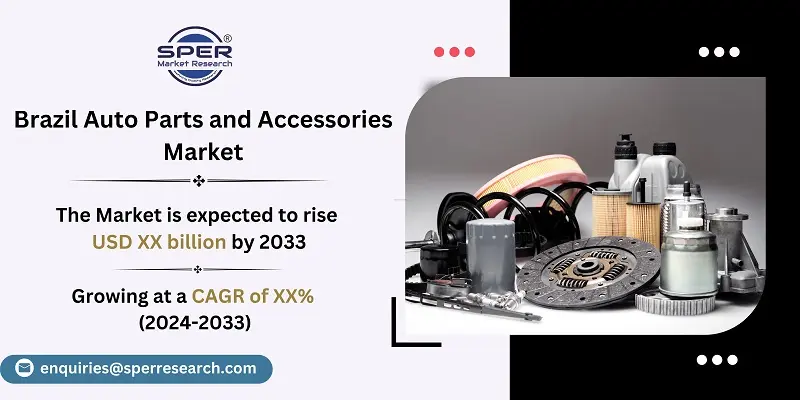
Brazil Auto Parts and Accessories Market Growth, Size, Trends, Share, Revenue and Future Outlook
Brazil Auto Parts and Accessories Market Size- By Product, By Application, By Distribution Channel- Regional Outlook, Competitive Strategies and Segment Forecast to 2033
| Published: Jul-2024 | Report ID: AMIN24161 | Pages: 1 - 101 | Formats*: |
| Category : Automotive & Transportation | |||
- October 2023; In an effort to raise car safety standards, Continental AG unveiled a new range of cutting edge safety systems designed specifically for the Brazilian market. These systems included improved braking systems and driver assistance technology.
- July 2023; At its Itatiba facility, Valeo started producing its new, highly efficient thermal systems with the goal of supplying essential parts for electric and hybrid vehicles to both domestic and foreign market.


| Report Metric | Details |
| Market size available for years | 2020-2033 |
| Base year considered | 2023 |
| Forecast period | 2024-2033 |
| Segments covered | By Product, By Application, By Distribution Channel |
| Regions covered | Northern Region, Northeast Region, Central West Region, Southeast Region, Southern Region. |
| Companies Covered | BorgWarner, Bosch, Continental AG, Denso Corporation, Faurecia, Lear Corporation, Magna International, Mahle GmbH, Tenneco (DRiV Incorporated), Valeo, and Others. |
- Automotive Aftermarket Shops
- Vehicle Owners
- Fleet Operators
- Retail Distributors
- Repair and Service Centers
- Export Market
- Government and Institutional Buyers
| By Product: |
|
| By Application: |
|
| By Distribution Channel: |
|
- Brazil Auto Parts and Accessories Market Size (FY’2024-FY’2033)
- Overview of Brazil Auto Parts and Accessories Market
- Segmentation of Brazil Auto Parts and Accessories Market by Product (Mechanical Parts, Electrical Parts, Body Parts, Others)
- Segmentation of Brazil Auto Parts and Accessories Market by Application (Automotive Repair Shops, Auto Enthusiasts)
- Segmentation of Brazil Auto Parts and Accessories Market by Distribution Channel (OEM, Aftermarket)
- Statistical Snap of Brazil Auto Parts and Accessories Market
- Expansion Analysis of Brazil Auto Parts and Accessories Market
- Problems and Obstacles in Brazil Auto Parts and Accessories Market
- Competitive Landscape in the Brazil Auto Parts and Accessories Market
- Impact of COVID-19 and Demonetization on Brazil Auto Parts and Accessories Market
- Details on Current Investment in Brazil Auto Parts and Accessories Market
- Competitive Analysis of Brazil Auto Parts and Accessories Market
- Prominent Players in the Brazil Auto Parts and Accessories Market
- SWOT Analysis of Brazil Auto Parts and Accessories Market
- Brazil Auto Parts and Accessories Market Future Outlook and Projections (FY’2024-FY’2033)
- Recommendations from Analyst
1.1. Scope of the report1.2. Market segment analysis
2.1. Research data source
2.1.1. Secondary Data2.1.2. Primary Data2.1.3. SPER’s internal database2.1.4. Premium insight from KOL’s
2.2. Market size estimation
2.2.1. Top-down and Bottom-up approach
2.3. Data triangulation
4.1. Driver, Restraint, Opportunity and Challenges analysis
4.1.1. Drivers4.1.2. Restraints4.1.3. Opportunities4.1.4. Challenges
4.2. COVID-19 Impacts of the Brazil Auto Parts and Accessories Market.
5.1. SWOT Analysis
5.1.1. Strengths5.1.2. Weaknesses5.1.3. Opportunities5.1.4. Threats
5.2. PESTEL Analysis
5.2.1. Political Landscape5.2.2. Economic Landscape5.2.3. Social Landscape5.2.4. Technological Landscape5.2.5. Environmental Landscape5.2.6. Legal Landscape
5.3. PORTER’s Five Forces
5.3.1. Bargaining power of suppliers5.3.2. Bargaining power of buyers5.3.3. Threat of Substitute5.3.4. Threat of new entrant5.3.5. Competitive rivalry
5.4. Heat Map Analysis
6.1. Brazil Auto Parts and Accessories Market Manufacturing Base Distribution, Sales Area, Product Type6.2. Mergers & Acquisitions, Partnerships, Product Launch, and Collaboration in Brazil Auto Parts and Accessories Market
7.1. Brazil Auto Parts and Accessories Market Size, Share and Forecast, By Product, 2020-20267.2. Brazil Auto Parts and Accessories Market Size, Share and Forecast, By Product, 2027-20337.3. Mechanical Parts7.4. Electrical Parts7.5. Body Parts7.6. Others
8.1. Brazil Auto Parts and Accessories Market Size, Share and Forecast, By Application, 2020-2026
8.2. Brazil Auto Parts and Accessories Market Size, Share and Forecast, By Application, 2027-20338.3. Automotive Repair Shops8.4. Auto Enthusiasts
9.1. Brazil Auto Parts and Accessories Market Size, Share and Forecast, By Distribution Channel, 2020-20269.2. Brazil Auto Parts and Accessories Market Size, Share and Forecast, By Distribution Channel, 2027-20339.3. OEM9.4. Aftermarket
10.1. Brazil Auto Parts and Accessories Market Size and Market Share
11.1. Brazil Auto Parts and Accessories Market Size and Market Share By Region (2020-2026)11.2. Brazil Auto Parts and Accessories Market Size and Market Share By Region (2027-2033)11.3. Northern Region11.4. Northeast Region11.5. Central West Region11.6. Southeast Region11.7. Southern Region
12.1. BORGWARNER
12.1.1. Company details12.1.2. Financial outlook12.1.3. Product summary12.1.4. Recent developments
12.2. BOSCH
12.2.1. Company details12.2.2. Financial outlook12.2.3. Product summary12.2.4. Recent developments
12.3. CONTINENTAL AG
12.3.1. Company details12.3.2. Financial outlook12.3.3. Product summary12.3.4. Recent developments
12.4. DENSO CORPORATION
12.4.1. Company details12.4.2. Financial outlook12.4.3. Product summary12.4.4. Recent developments
12.5. FAURECIA
12.5.1. Company details12.5.2. Financial outlook12.5.3. Product summary12.5.4. Recent developments
12.6. LEAR CORPORATION
12.6.1. Company details12.6.2. Financial outlook12.6.3. Product summary12.6.4. Recent developments
12.7. MAGNA INTERNATIONAL
12.7.1. Company details12.7.2. Financial outlook12.7.3. Product summary12.7.4. Recent developments
12.8. MAHLE GMBH
12.8.1. Company details12.8.2. Financial outlook12.8.3. Product summary12.8.4. Recent developments
12.9. VALEO
12.9.1. Company details12.9.2. Financial outlook12.9.3. Product summary12.9.4. Recent developments
12.10. Others
SPER Market Research’s methodology uses great emphasis on primary research to ensure that the market intelligence insights are up to date, reliable and accurate. Primary interviews are done with players involved in each phase of a supply chain to analyze the market forecasting. The secondary research method is used to help you fully understand how the future markets and the spending patterns look likes.
The report is based on in-depth qualitative and quantitative analysis of the Product Market. The quantitative analysis involves the application of various projection and sampling techniques. The qualitative analysis involves primary interviews, surveys, and vendor briefings. The data gathered as a result of these processes are validated through experts opinion. Our research methodology entails an ideal mixture of primary and secondary initiatives.



Frequently Asked Questions About This Report
PLACE AN ORDER
Year End Discount
Sample Report
Pre-Purchase Inquiry
NEED CUSTOMIZATION?
Request CustomizationCALL OR EMAIL US
100% Secure Payment






Related Reports
Our Global Clients
Our data-driven insights have influenced the strategy of 200+ reputed companies across the globe.




















